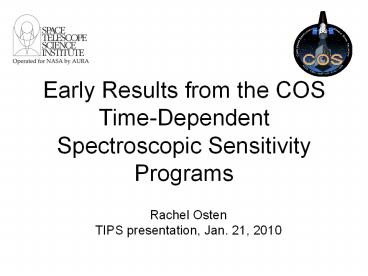Early Results from the COS Time-Dependent Spectroscopic Sensitivity Programs - PowerPoint PPT Presentation
1 / 12
Title:
Early Results from the COS Time-Dependent Spectroscopic Sensitivity Programs
Description:
Title: Early Results from the COS Time-Dependent Spectroscopic Sensitivity Programs Last modified by: Preferred User Document presentation format – PowerPoint PPT presentation
Number of Views:77
Avg rating:3.0/5.0
Title: Early Results from the COS Time-Dependent Spectroscopic Sensitivity Programs
1
Early Results from the COS Time-Dependent
Spectroscopic Sensitivity Programs
- Rachel Osten
- TIPS presentation, Jan. 21, 2010
2
Overview
- Absolute flux calibration of NUV, FUV channels
done during SMOV - Cycle 17 calibration programs (11896 11897)
monitor time-dependence of sensitivity using
external observations of standard stars to
capture e.g. contamination - Low- and medium-resolution gratings are observed
roughly monthly and quarterly, respectively - exceptions are two of the NUV gratings which are
observed monthly
3
NUV Gratings
- G225M, G285M gratings are coated with bare
aluminum - the other NUV gratings on COS (G230L and G185M)
are AlMgF2 - bare Al quickly develops a thin oxide coating
- the expectation was that this coating would
stabilize once in the vacuum of space - ground-based Grating Efficiency Tests (GETs) done
from 2003 onward demonstrated a degradation of
grating efficiency for the G225M and G285M
gratings - similar GET was performed during SMOV
4
NUV Grating Efficiency Test results
- G230L, G185M (MgF2Al coated) appear stable
- G225M and G285M show efficiency decline 1.6 per
year (G225M) and 4.5 per year (G285M) - data point in red is from SMOV
- SMOV data consistent with ground trends
5
NUV Grating Efficiency Test results
measurements at specific wavelengths appear
consistent within a given grating
6
On-orbit results with external targets
WD1057719 _at_2635Å
G191B2B _at_2186Å
G191B2B _at_2617Å
stripe A
stripe A
stripe A
stripe B
stripe B
stripe B
stripe C
stripe C
stripe C (2nd order)
7
summary of NUV data
- observations spanning 5 months so far
- G230L stable, with 6 observations spanning 5
months - G185M also appears stable, only 2 observations
- Bare-Al gratings appear to indicate continued
sensitivity degradation on-orbit - 3 per year for G225M, 10-12 per year for G285M
- G225M grating is used for 0.7 of time in COS
Cycle 17 (by exposure time) G285M is used for
2.7 of time - results were confirmed by manual extraction of
spectra not a pipeline issue - repeatability in NUV estimated to be 1-2
- no good current explanation for the on-orbit
degradation
8
FUV TDS
G140L 1105Å
WD0947857
9
FUV TDS
G140L 1230Å
WD0947857
10
FUV summary
- observations span 4 months, 5 data points for
G140L - using the standard error of the mean as the
uncertainty, TDS slopes are large - if systematic errors are larger (1.5
repeatability), then uncertainty on slopes is
larger - there is a systematic behavior in G130M G160M
gratings, where second data point is down by
2-3 not enough data points for a given
grating/cenwave to see a trend - confirmed trends using manual extraction of
spectra - no flat-field is currently applied to data
- need more data to conclude whether this is a
physical effect
11
STIS TDS results
nothing apparent from STIS -- no OTA effect
12
COS TDS summary































